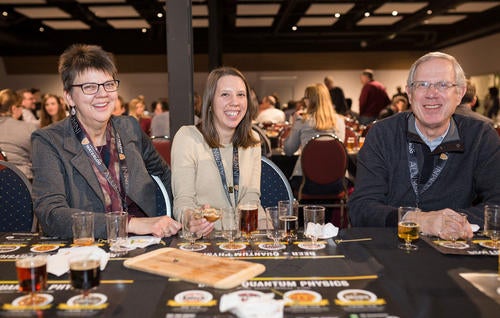
Commercializing Canadian research and moving it to the marketplace
What does the future hold for Canadian invention?

What does the future hold for Canadian invention?
By Natalie Quinlan University RelationsFrom clean technologies to quantum computing, laboratories to industry, startup ideas to global relevance, what does the future hold for Canadian invention?
That question was tabled during a panel discussion hosted in partnership with progressive think-tank Canada 2020.
More than 200 Waterloo alumni and students attended the Ottawa event to discuss Canada's relevance in the global market, identifying culture, risk-taking and funding as key factors.
"Canada, as an advanced economy no longer relies on making things cheaper, we rely on making things smarter," said Mihaela Luminita Vlasea, associate research director, additive manufacturing & assistant professor for the Faculty of Engineering at the University of Waterloo. "Either designs or products or manufacturing processes, that's where we have a competitive advantage."
Hosted at Canada's Science and Technology Museum, audiences discussed the country's growing economy, while panelists offered proactive solutions for marketplace growth.
"There are three [solutions]: the first is money—our companies need to be able to access capital," said Mike Moffatt, director of policy and innovation for Canada 2020. "The second is talent—companies need to be able to hire the people they need to grow. And I think the third is ambition—we really need to think large and realize that we can compete with anyone in the world."
The evening served as a collaborative outlet, engaging an audience of alumni and community members on the highs and hurdles of remaining globally relevant.
"I think a topic like this has so many moving parts, there's no one person that has the answer, there's no one silver bullet," said Jay Shah (BASc ’11), director of Velocity . "You all bring something different to the conversation and the amalgamation of that in some way is going to be what causes the ecosystem to succeed, so we need everybody's opinion to come up with the right solution."

Following the panel, guests explored the museum's quantum exhibition, a first-of-its-kind showcase examining how a merge of quantum mechanics and information technology will revolutionize the twenty-first century. This was part of an alumni event series called Beer + Quantum, which was hosted across the country as the exhibit travelled from museum to museum over the last year. With more than 8,300 alumni in Ottawa, the event sold out quickly. Honourable guests such as Minister of Small Business and Tourism & MP for Waterloo Bardish Chagger (BSc ’04), and MP for Kitchener Centre Raj Saini were also in attendance.
"The knowledge and innovation coming out of the University of Waterloo is second to none," said Chagger. "When the University of Waterloo is here, present in the nation's capital, the whole country benefits from everything we have to offer, so it's important that we continue to offer events like this."
"Waterloo Region is very special," added Saini. "We have all kind of sectors that exist there but one of the most important sectors that we have is the high-tech sector, and quantum computing is very important not only for Waterloo region, but going forward, it's important for the world."
Missed the panel? Hear the full podcast here.

Read more
Lesson 2.5: how jellyfish can change your perspective on R&D

Read more
Leaders tell Waterloo Innovation Summit to fund basic research to commercialize unexpected outcomes

Read more
Governments and corporations need to start thinking about quantum era security right now, says Waterloo researcher
The University of Waterloo acknowledges that much of our work takes place on the traditional territory of the Neutral, Anishinaabeg, and Haudenosaunee peoples. Our main campus is situated on the Haldimand Tract, the land granted to the Six Nations that includes six miles on each side of the Grand River. Our active work toward reconciliation takes place across our campuses through research, learning, teaching, and community building, and is co-ordinated within the Office of Indigenous Relations.